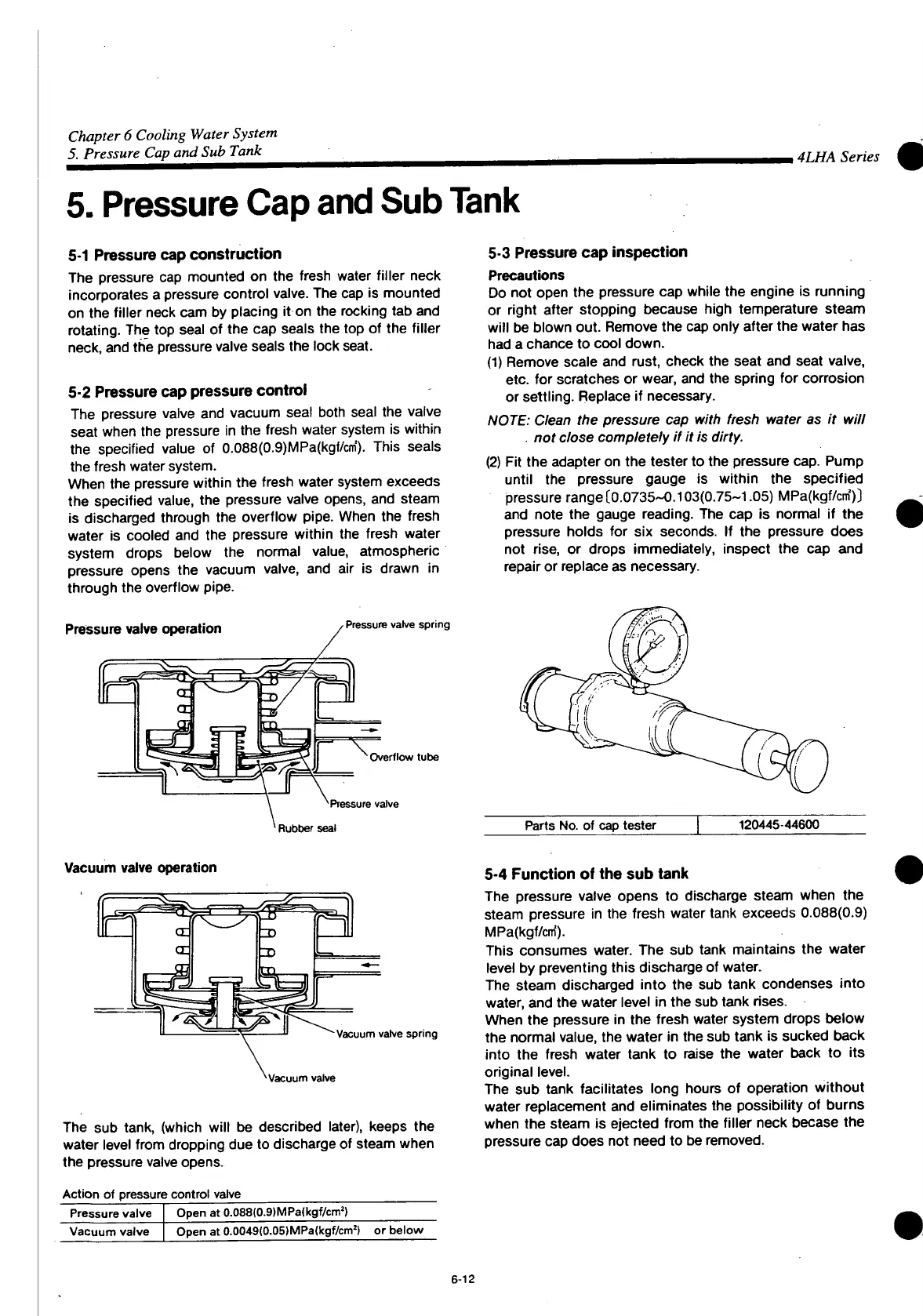Chapter 6 Cooling Water System
5. Pressure Cap and Sub Tank
,
4LHA Series
5.
Pressure
Cap and Sub
Tank
5-1
Pressure
cap
construction
The pressure cap mounted on the fresh water filler neck
incorporates a pressure control valve. The cap is mounted
on the filler neck cam by placing it on the rocking tab and
rotating. The top seal of the cap seals the top of the filler
neck, and the pressure valve seals the lock seat.
5-2
Pressure
cap
pressure
controi
The pressure valve and vacuum seal
both
seal the valve
seat when the pressure in the fresh water system is
within
the specified value of 0.088(0.9)MPa(kgf/cm). This seals
the fresh water system.
When the pressure
within
the fresh water system exceeds
the specified value, the pressure valve opens, and steam
is
discharged through the overflow pipe. When the fresh
water is cooled and the pressure
within
the fresh water
system drops below the normal value, atmospheric
pressure opens the vacuum valve, and air is drawn in
through the overflow pipe.
Pressure
valve
operation
Pressure
valve spring
Overflow tube
Pressure
valve
Rubber
seal
5-3
Pressure
cap
inspection
Precautions
Do
not open the pressure cap while the engine is running
or
right
after stopping because high temperature steam
will
be blown out. Remove the cap only after the water has
had a chance to cool down.
(1) Remove scale and rust, check the seat and seat valve,
etc. for scratches or wear, and the spring for corrosion
or settling. Replace if necessary.
NOTE: Clean the pressure cap with fresh water as it will
not close completely if it is dirty.
(2) Fit the adapter on the tester to the pressure cap. Pump
until
the pressure gauge is
within
the specified
pressure range [0.0735-0.103(0.75-1.05) MPa(kgf/cm)]
and note the gauge reading. The cap is normal if the
pressure holds for six seconds. If the pressure does
not rise, or drops immediately, inspect the cap and
repair or replace as necessary.
Parts
No. of cap tester
120445-44600
Vacuum
valve
operation
Vacuum
valve spring
Vacuum
valve
The sub tank, (which
will
be described later), keeps the
water level
from
dropping due to discharge of steam when
the pressure valve opens.
Action of pressure control valve
Pressure
valve
Open
at 0.088(0.9)MPa(kgf/cm
!
)
Vacuum
valve
Open
at 0.0049(0.05)MPa(kgf/cm
J
) or below
5-4
Function
of the sub
tank
The pressure valve opens to discharge steam when the
steam pressure in the fresh water
tank
exceeds 0.088(0.9)
MPa(kgf/cm).
This consumes water. The sub
tank
maintains the water
level by preventing this discharge of water.
The steam discharged
into
the sub
tank
condenses
into
water, and the water level in the sub
tank
rises.
When the pressure in the fresh water system drops below
the normal value, the water in the sub
tank
is sucked back
into
the fresh water
tank
to raise the water back to its
original level.
The sub
tank
facilitates long hours of operation
without
water replacement and eliminates the possibility of burns
when the steam is ejected
from
the filler neck becase the
pressure cap does not need to be removed.
6-12

